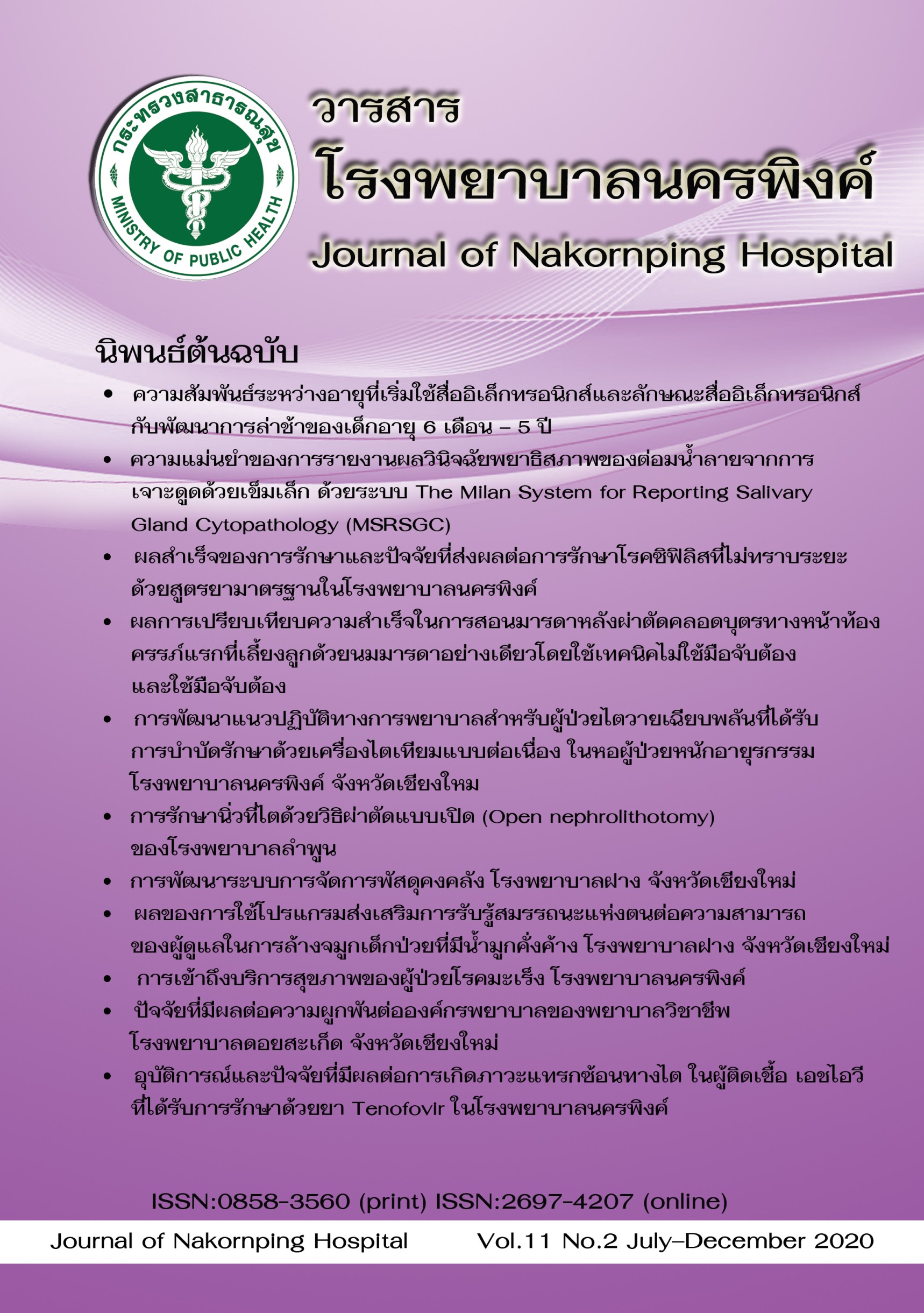Development Clinical Nursing Practice Guideline for Acute Kidney Injury Patients with Continuous Renal Replacement Therapy in Medical Intensive Care Unit Nakornping Hospital, Chiang Mai Province
Keywords:
Clinical Nursing Practice guidelines, acute kidney injury patients, continuous renal replacement therapyAbstract
Objective:, To develop and evaluate the effect of clinical practice guidelines for acute kidney injury patients receiving continuous renal replacement therapy.
Methods: This research and developmental study consists of the nursing processes which can be divided into 3 phases, before -treatment, treatment period, and the end of treatment period. Samples included 1) 54 professional nurses in intensive care unit of medicine 1, 2, 3 and stroke unit, and 2) patients before and after using the guideline, 68 and 64 patients, respectively. Study period was done during March 2018 and December 2019. Data collection tools consisted of 1) the personal data record form of nurses and patients 2) Questionnaire on nursing practice guidelines 3) The activity practice questionnaire according to the nursing practice guidelines. 4) Outcomes record forms. Data were analyzed using descriptive statistics, chi-square, while outcomes data were analyzed using linear regression and logistic regression.
Results: This study outcome had been done and resulted in a newly developed clinical nursing practice guideline for acute kidney injury in patients with continuous renal replacement therapy in medical intensive care unit. Nurses who used the clinical practice guidelines had the highest level of opinions (94.4 %). After the implementation of the guidelines, most of the activities were performed. Treatment outcomes had statistically significant in maintaining longer duration of continuous renal replacement therapy at Adj.mean dif 34.92 hours [95%CI (27.25 - 38.63) (p < 0.001)]. Regarding complication, for example, the filter clotting had decreased, Adj. Odds ratio 0.11 [95 % CI (0.05 - 0.27) (P < 0.001)] and mean of serum BUN had decreased from baseline, Adj.mean dif -16.04 [95 % CI (-29.72, -2.36) (P < 0.022)].
Conclusion: The developed CNPG is suitable for patients in the medical intensive care unit. Treatment outcomes were improved and there was increase in nursing activities practice according to nursing practice in each phase of treatment.
References
อดิศว์ ทัศณรงค์. ภาวะไตบาดเจ็บเฉียบพลัน = Acute kidney injury. กรุงเทพฯ: หมอชาวบ้าน; 2557.
สำนักงานหลักประกันสุขภาพแห่งชาติ. รายงานการสร้างระบบหลักประกันสุขภาพแห่งชาติ ประจำปีงบประมาณ 2561. นนทบุรี: สหมิตรพริ้นติ้งแอนด์พับลิสชิ่ง; 2562.
Case J, Khan S, Khalid R, Khan A. Epidemiology of acute kidney injury in the intensive care unit. Crit Care Res Pract. 2013;2013:479730.
Moore E, Bellomo R, Nichol AD. The meaning of acute kidney injury and its relevance to intensive care and anaesthesia. Anaesth Intensive Care. 2012;40(6):929-48.
Bellomo R, Kellum JA, Ronco C. Acute kidney injury. The Lancet. 2012;380(9843):756-766.
พยอม บุญสุด, สุจิตรา ลิ้มอำนวยลาภ. ผลการพัฒนาแนวปฏิบัติการพยาบาลทางคลินิกในการดูแลผู้ป่วยไตบาดเจ็บเฉียบพลันที่รักษาด้วยการบำบัดทดแทนไตอย่างต่อเนื่องในหอผู้ป่วยวิกฤต. วารสารสมาคมพยาบาลฯ สาขาภาคตะวันออกเฉียงเหนือ. 2554;29(4):50-57.
กัลยพัทธ์ นิยมวิทย์, จริยาพร วรรณโชติ. การพยาบาลผู้ป่วยวิกฤตเด็กที่มีภาวะไตบาดเจ็บเฉียบพลันที่ได้รับการบำบัดทดแทนไตชนิด Continuous Venovenous Hemofiltration Nursing Care for Critically Ill Children with Acute Kidney Injury Using Continuous Venovenous Hemofiltration. วารสารวิทยาลัยพยาบาลพระปกเกล้า จันทบุรี. 2559;27(2):149-159.
Schoenfelder T, Chen X, Bleb HH. Effects of continuous and intermittent renal replacement therapies among adult patients with acute kidney injury. GMS Health Technol Assess. 2017;13.
Oh HJ, Shin DH, Lee MJ, Koo HM, Doh FM, Kim HR, et al. Early initiation of continuous renal replacement therapy improves patient survival in severe progressive septic acute kidney injury. J Crit Care. 2012;27(6):743.e9–18.
Brain M, Winson E, Roodenburg O, McNeil J. Non anti-coagulant factors associated with filter life in continuous renal replacement therapy (CRRT): a systematic review and meta-analysis. BMC. Nephrology. 2017;18(1):69
National Health and Medical Research Council [NHMRC]. A Guide to the Development Implementation and Evaluation of Clinical Practice Guidelines.1998 [Internet]. Australian: National Health and Medical Research Council; 1998 [cite 2018 Aug 18]. Available from: https://www.health.qld.gov.au/__data/assets/pdf_file/0029/143696/nhmrc_clinprgde.pdf
โรงพยาบาลนครพิงค์. ข้อมูลสถิติโรคไตวายเฉียบพลันประจำปี 2561. เชียงใหม่: โรงพยาบาลนครพิงค์; 2561
โรงพยาบาลนครพิงค์. ข้อมูลหอผู้ป่วยหนักอายุรกรรมประจำปี 2560. เชียงใหม่: โรงพยาบาลนครพิงค์; 2560
สุชาดา บุญแก้ว. Advance for Continuous Renal Replacement Therapy. ใน: กิจกรรมพัฒนาบุคลากร ฝ่ายการพยาบาล โรงพยาบาลมหาราชนครเชียงใหม่ เดือน มีนาคม 2561; 12-13 มีนาคม 2561; ณ ห้องประชุม 153 ชั้น 15 อาคารสุจิณโณ คณะแพทยศาสตร์ มหาวิทยาลัยเชียงใหม่. เชียงใหม่; 2561.
Joanna Briggs Institute. JBI Levels of evidence and grade of recommendations [Internet]; 2011. Retrieved from: http://www.joannabriggs.edu.au
González de Molina FJ, Galindo M, González C, Broch MJ, Del Bano L, Roglan A. Vascular access and extracorporeal circuit patency in continuous renal replacement therapy. Med Intensiva. 2016;40(9):572-58.
อรวรรณ ขันสำรี. การพยาบาลในขณะบำบัดทดแทนไตแบบต่อเนื่อง. ใน: ณัฐชัย ศรีสวัสดิ์, สมชาย เอี่ยมอ่อง, เกรียง ตั้งสง่า, เกื้อเกียรติ ประดิษฐ์พรศิลป์, ขจร ตีรณธนากุล, สดุดี พีรพรรัตนา, บรรณาธิการ. Textbook of CRRT. กรุงเทพฯ: เท็กซ์ แอนด์ เจอร์นัล พับลิเคชั่น; 2560. หน้า 181-197.
กิตติยา เสทธะยะ. ผลของการเพิ่มปริมาณช่องว่างในกระเปาะ สายส่งเลือดต่อการอุดตันในวงจรไตเทียมโดยไม่ใช้ยาต้านการแข็งตัวของเลือด.พุทธชินราชเวชสาร. 2557;31(1):5-14.
Downloads
Published
How to Cite
Issue
Section
License
The articles that had been published in the journal is copyright of Journal of Nakornping hospital, Chiang Mai.
Contents and comments in the articles in Journal of Nakornping hospital are at owner’s responsibilities that editor team may not totally agree with.



